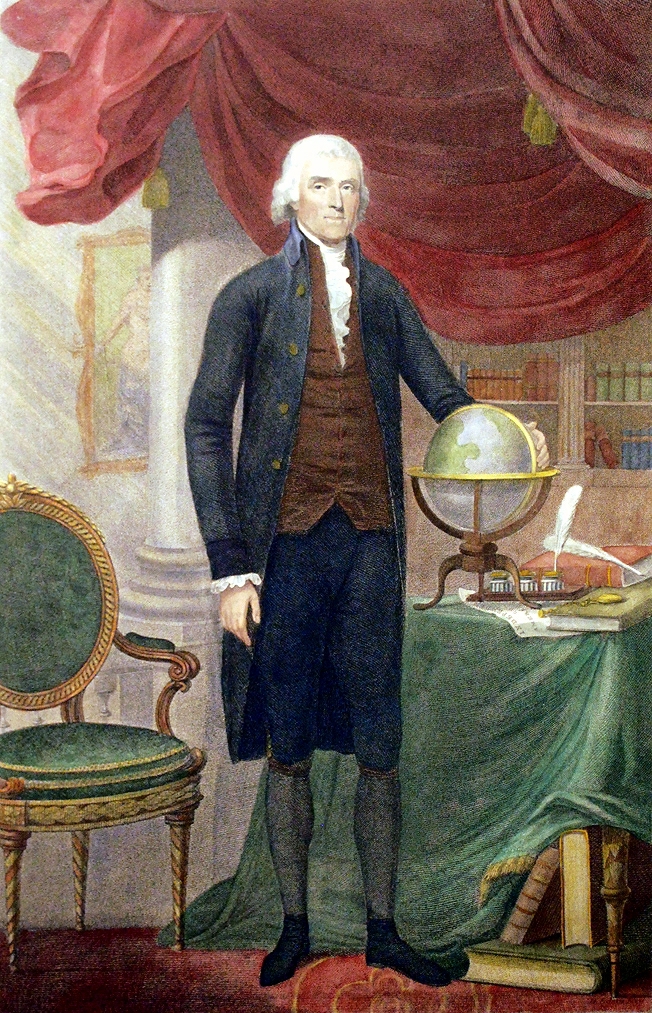Thomas Jefferson
Jefferson was born in 1743 in Shadwell, Virginia to Peter Jefferson, a surveyor, and his wife Jane Randolph Jefferson, a member of the very wealthy and prominent Randolph family.[1] The elder Jefferson died when Thomas was only 14, leaving to his son an estate of 5,000 acres and many slaves.[2] Three years later, Jefferson enrolled at William & Mary College – studying mathematics, metaphysics, and philosophy under the tutelage of Dr. William Small.[3]
Small recognized great promise in Jefferson and recommended him to George Wythe, one of the most prominent lawyers in Virginia, as an apprentice.[4] At that time in the colonies, there were no law schools; most budding lawyers learned by apprenticing themselves to a practicing attorney. Jefferson spent the next seven years learning the intricacies of the law under Wythe until Jefferson was admitted to the bar in 1767.[5] Wythe’s tutelage had a profound impact on the young lawyer. In his autobiography, Jefferson recognized Wythe as one of the three most influential men in his life, along with Dr. Small and Jefferson’s benefactor, Peyton Randolph.[6] Jefferson described Wythe as "my faithful and beloved mentor in youth and my most affectionate friend through life"[7] and "my ancient master, my earliest and best friend."[8]
In 1769, Jefferson added a political career to his practice of law, being elected to the Virginia House of Burgesses.[9] He gained notoriety for his support of the revolutionary cause, and in 1775 Jefferson was elected to the Second Continental Congress where he began drafting revolutionary state papers.[10] In June, 1776, Jefferson was tasked to draft a declaration of independence from Britain that would fairly represent all 13 colonies.
Jefferson’s political career continued after his service in the Continental Congress. He served as Governor of Virginia (1779-1781), Minister to France (1785-89), Secretary of State (1790-1793), Vice President (1797-1801), and ultimately as President of United States (1801-1809).
Finished with politics after his second term as president, Jefferson retired to Monticello, the home he had built near Charlottesville, Virginia. As an avid student of architecture, he modeled the house after the work of Italian Renaissance master Andrea Palladio;[11] he repeated a similar design in his later works—the Virginia Capitol, Poplar Forest, and the University of Virginia.[12]
Jefferson wrote his own epitaph. In it, he identified the accomplishments of which he was most proud: the Declaration of Independence, the Virginia Statute for Religious Freedom, and the founding of the University of Virginia.[13] Jefferson died at Monticello on July 4th, 1826—the 50th anniversary of the announcement of American independence. Coincidentally, John Adams, a partner in the Continental Congress, a bitter political rival, and ultimately a rediscovered friend, died on the same day. Adam's reported last words, knowing nothing of Jefferson’s death earlier on that same morning, were “Thomas Jefferson still survives.”[14]
References
- ↑ Merrill D. Peterson, “Jefferson, Thomas” in American National Biography Online, accessed 21 October 2013, http://www.anb.org/articles/02/02-00196.html.
- ↑ Ibid.
- ↑ Merrill D. Peterson, Thomas Jefferson and the New Nation: A Biography (New York: Oxford University Press, 1970), .
- ↑ Fawn McKay Brodie, Thomas Jefferson, an Intimate History, 1st ed. (New York: Norton, 1974), 45.
- ↑ Peterson, "Jefferson, Thomas."
- ↑ Brodie, Thomas Jefferson: An Intimate History, 110
- ↑ Thomas Jefferson, Autobiography of Thomas Jefferson (Raleigh, N.C.: Alex Catalogue), 5.
- ↑ "[Jefferson to William DuVal, 14 June 1808]," The Thomas Jefferson Papers, Library of Congress, http://hdl.loc.gov/loc.mss/mtj.mtjbib016197.
- ↑ Peterson, “Jefferson, Thomas.”
- ↑ Ibid.
- ↑ Ibid.
- ↑ Ibid.
- ↑ Ibid.
- ↑ Ibid.
